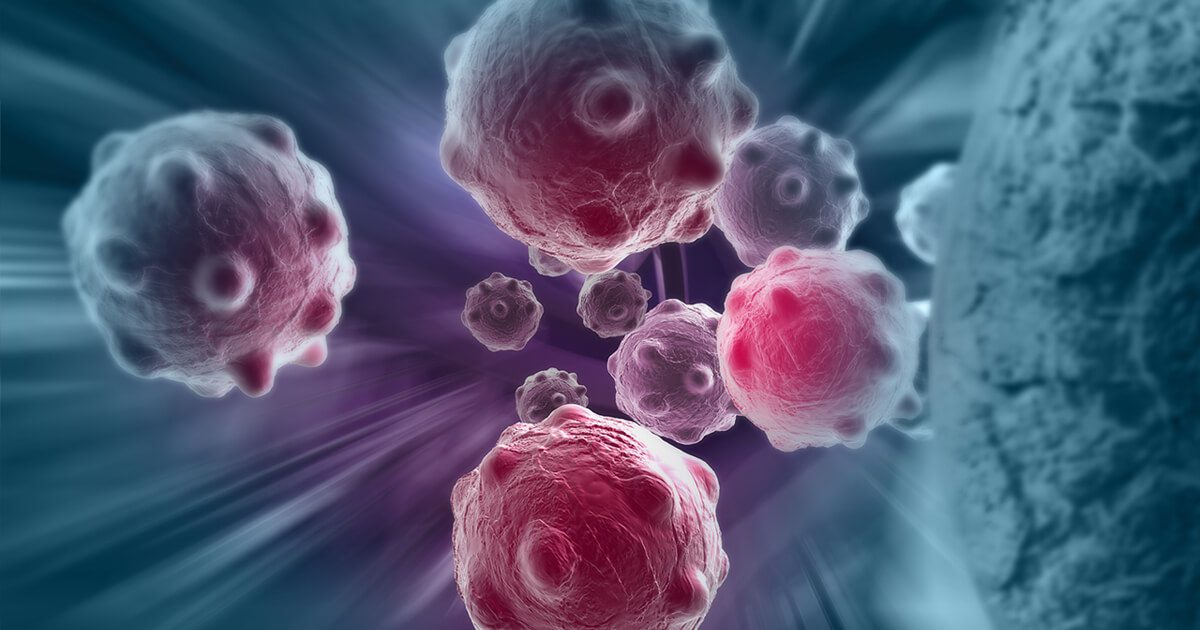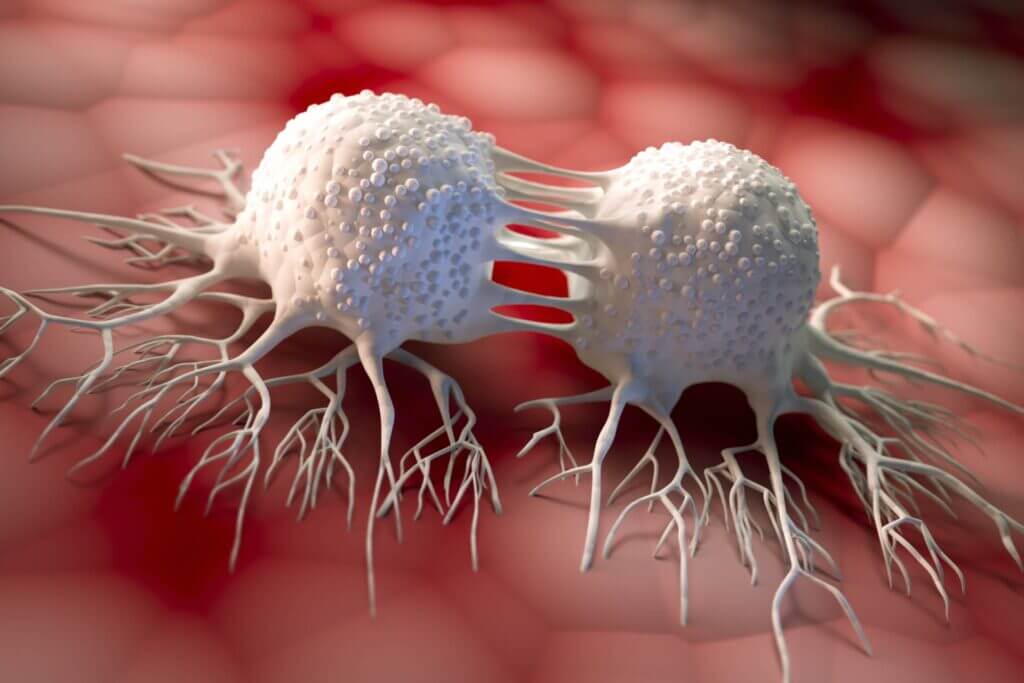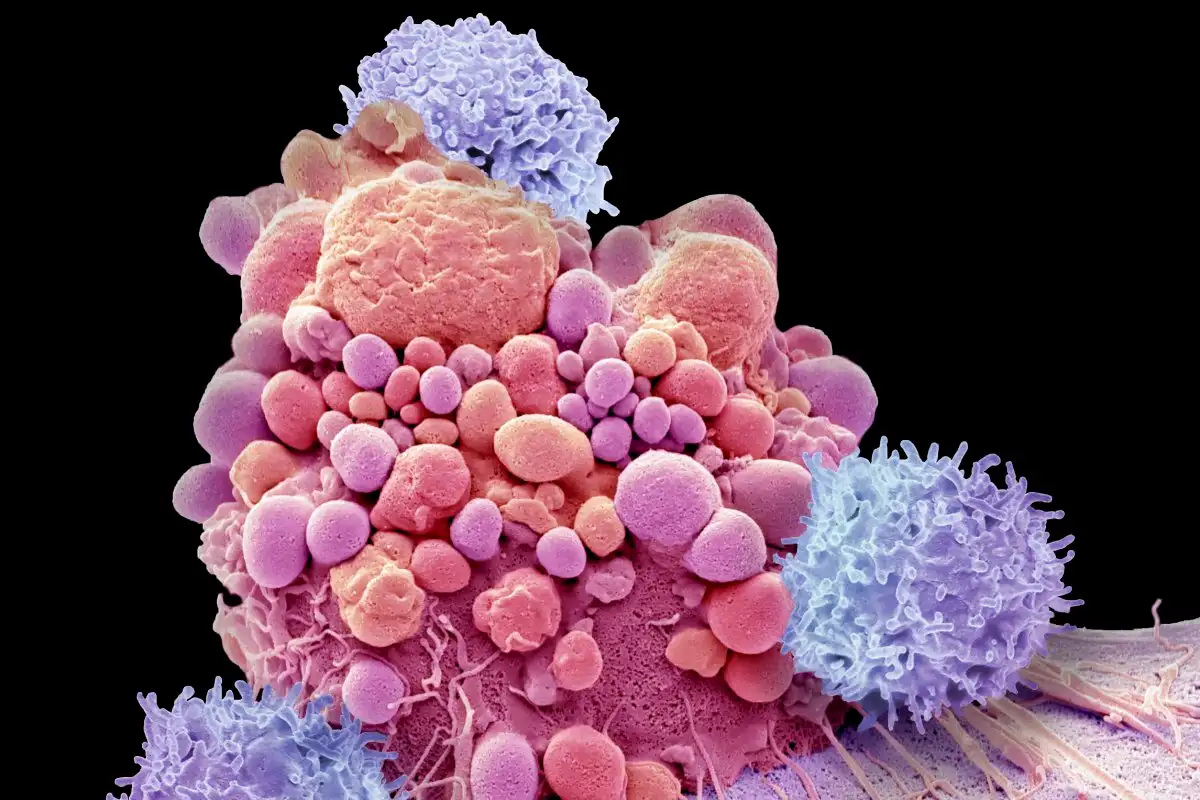
Cancer, also known as malignancy, refers to a broad group of diseases characterized by the uncontrolled growth and spread of abnormal cells. These abnormal cells have the potential to invade and damage surrounding tissues and organs, disrupting their normal functioning.
In a healthy body, cells grow and divide in a regulated manner to replace old or damaged cells. However, in the case of cancer, genetic mutations or other abnormalities occur within the DNA of cells, causing them to divide and grow uncontrollably. The accumulating mass of abnormal cells forms a tumour, which can be either benign (non-cancerous) or malignant (cancerous).
Malignant tumours are particularly concerning because they have the ability to invade nearby tissues and spread to other parts of the body through a process called metastasis. This spreading of cancer cells via the bloodstream or lymphatic system can lead to the formation of secondary tumours in different organs or tissues, further compromising their function.
Cancer can affect any part of the body and can manifest in various forms. Common types of cancer include breast cancer, lung cancer, colorectal cancer, prostate cancer, and skin cancer, among many others. The signs and symptoms of cancer depend on the type and stage of the disease but may include unexplained weight loss, fatigue, pain, changes in the skin, abnormal bleeding, and persistent coughing or hoarseness.
The causes of cancer are multifactorial and can involve a combination of genetic factors, environmental exposures (such as tobacco smoke or certain chemicals), lifestyle choices (like a poor diet or lack of physical activity), infections, and certain medical conditions.
Early detection, through regular screenings and awareness of potential symptoms, can improve the chances of successful treatment. Treatment options for cancer include surgery, radiation therapy, chemotherapy, targeted therapy, immunotherapy, and hormone therapy. The choice of treatment depends on factors such as the type and stage of cancer, as well as the overall health of the individual.
Types of Cancer
There are numerous types of cancer, as the disease can affect virtually any part of the body. Here are some common types of cancer:
Breast cancer: Affects the breast tissue, predominantly in women, but it can also occur in men.
Lung cancer: Develops in the lungs, usually due to long-term exposure to tobacco smoke. It is the leading cause of cancer-related deaths worldwide.
Colorectal cancer: Begins in the colon or rectum and is often associated with precancerous polyps in the digestive tract.
Prostate cancer: Occurs in the prostate gland, which is a part of the male reproductive system.
Skin cancer: The most common types are basal cell carcinoma, squamous cell carcinoma, and melanoma. Skin cancer develops in the cells of the skin and is often caused by excessive exposure to ultraviolet (UV) radiation from the sun or tanning beds.
Bladder cancer: Forms in the tissues of the bladder, the organ responsible for storing urine.
6 symptoms appear at the onset of blood cancer
Leukaemia: A cancer of the blood or bone marrow, characterized by the rapid production of abnormal white blood cells. There are different types of leukaemia, including acute lymphoblastic leukaemia (ALL), acute myeloid leukaemia (AML), chronic lymphocytic leukaemia (CLL), and chronic myeloid leukaemia (CML).
Lymphoma: Affects the lymphatic system, a network of vessels and glands that help fight infection. The two main types of lymphoma are Hodgkin lymphoma and non-Hodgkin lymphoma.
Pancreatic cancer: Develops in the pancreas, an organ involved in digestion and the regulation of blood sugar levels.
Ovarian cancer: Begins in the ovaries, which are part of the female reproductive system.
Brain cancer: Can originate in the brain itself (primary brain cancer) or spread to the brain from other parts of the body (secondary or metastatic brain cancer).
Pancreatic cancer: Develops in the pancreas, an organ involved in digestion and the regulation of blood sugar levels.
Ovarian cancer: Begins in the ovaries, which are part of the female reproductive system.
Brain cancer: Can originate in the brain itself (primary brain cancer) or spread to the brain from other parts of the body (secondary or metastatic brain cancer).
Kidney cancer: Starts in the kidneys, which are responsible for filtering waste from the blood to form urine.
Liver cancer: Occurs in the liver, a vital organ involved in metabolism, digestion, and detoxification.
Oesophageal cancer: Develops in the oesophagus, the tube that carries food from the throat to the stomach.
Stomach cancer: Affects the stomach lining and is often associated with long-term infection by Helicobacter pylori bacteria.
Cervical cancer: Arises in the cervix, the lower part of the uterus, and is often linked to persistent infection with certain strains of the human papillomavirus (HPV).
Testicular cancer: Begins in the testicles, the male reproductive organs responsible for producing sperm and testosterone.
Thyroid cancer: Originates in the thyroid gland, which produces hormones that regulate metabolism.
Bone cancer: Can develop in the bones and is classified as either primary (originating in the bone) or secondary (resulting from the spread of cancer from elsewhere in the body).
Soft tissue sarcoma: Refers to a group of cancers that arise in the soft tissues of the body, including muscles, tendons, fat, blood vessels, and nerves.
Multiple myeloma: A cancer of plasma cells, a type of white blood cell, that accumulates in the bone marrow.
Head and neck cancer: This can affect various parts of the head and neck region, including the mouth, throat, larynx, nasal cavity, and salivary glands.
Remember that this is not an exhaustive list, as there are many other types and subtypes of cancer. Each type of cancer has its own unique characteristics, risk factors, symptoms, and treatment options. If you suspect you may have cancer or have concerns, it is important to consult with a healthcare professional for proper evaluation and diagnosis.
Symptoms of cancer
The symptoms of cancer can vary widely depending on the type, stage, and location of the cancer. Some common signs and symptoms that may indicate the presence of cancer include:
Unexplained weight loss: Significant and unintentional weight loss, often associated with loss of appetite, can be a symptom of various types of cancer.
Fatigue: Persistent and unexplained tiredness or lack of energy that doesn’t improve with rest can be a symptom of cancer.
Pain: Ongoing or persistent pain in a specific area of the body that doesn’t go away can be a sign of cancer. However, it’s important to note that pain is not always present in the early stages of cancer.
Changes in the skin: Skin changes can include the development of new moles or growths, changes in the colour, size, or shape of existing moles, or the appearance of skin lesions that don’t heal.
Changes in bowel or bladder habits: Persistent changes in bowel movements (such as diarrhoea, constipation, or blood in the stool) or changes in urinary habits (such as blood in the urine or frequent urination) may be signs of certain types of cancer, such as colorectal, bladder, or prostate cancer.
Persistent cough or hoarseness: A chronic cough that doesn’t go away, coughing up blood, or persistent hoarseness can be signs of lung, throat, or laryngeal cancer.
Abnormal bleeding: Unusual bleeding or discharge from any part of the body, such as blood in the urine, stool, or coughing up blood, as well as abnormal vaginal bleeding or bleeding between periods, may indicate various types of cancer.
Difficulty swallowing: Persistent difficulty swallowing, known as dysphagia, can be a symptom of cancers in the oesophagus, throat, or stomach.
Changes in a mole or wart: Any changes in the colour, shape, size, or texture of a mole or wart, or the development of new moles, should be evaluated by a healthcare professional.
Persistent indigestion or discomfort: Chronic indigestion, stomach pain, or discomfort that doesn’t go away after treatment or dietary changes may be a symptom of stomach, pancreatic, or ovarian cancer.
It is important to note that these symptoms can also be caused by conditions other than cancer. However, if you experience any of these symptoms or have concerns about your health, it’s essential to consult with a healthcare professional for a proper evaluation and diagnosis. Early detection and timely medical intervention are crucial for effective cancer treatment.
Causes of Cancer
Cancer is a complex disease, and its causes can be multifactorial. There is rarely a single cause of cancer, but rather a combination of factors that contribute to its development. Here are some common factors that can increase the risk of developing cancer:
- Genetic factors: Certain genetic mutations inherited from parents can increase the risk of developing specific types of cancer. However, inherited genetic mutations are responsible for a small percentage of cancer cases. Most cancers are not directly inherited but develop due to a combination of genetic and environmental factors.
- Environmental factors: Exposure to certain substances in the environment can increase the risk of cancer. These include:
- Carcinogens: Substances known to cause cancer, such as tobacco smoke, asbestos, benzene, formaldehyde, certain pesticides, and industrial chemicals.
- Radiation: High levels of ionizing radiation, such as exposure to medical radiation (e.g., repeated CT scans) or radiation from nuclear accidents or radioactive materials, can increase the risk of cancer.
- Ultraviolet (UV) radiation: Excessive exposure to UV radiation from the sun or tanning beds increases the risk of skin cancer.
- Air pollution: Prolonged exposure to air pollutants, such as those released from vehicles, factories, or certain chemicals, may contribute to the development of cancer.
- Lifestyle factors: Unhealthy lifestyle choices can increase the risk of cancer. These include:
- Tobacco use: Smoking and tobacco products are strongly linked to various types of cancer, including lung, throat, mouth, oesophagal, and bladder cancer.
- Diet: A poor diet lacking in fruits, vegetables, and whole grains and high in processed foods, red meat, and excessive calorie intake can increase the risk of certain cancers.
- Physical inactivity: A sedentary lifestyle with little physical activity is associated with an increased risk of several types of cancer.
- Alcohol consumption: Heavy and regular alcohol consumption is linked to an increased risk of cancers of the liver, mouth, throat, oesophagus, and breast.
- Obesity: Excess body weight and obesity are associated with an increased risk of several types of cancer, including breast, colorectal, pancreatic, and kidney cancer.
- Infectious agents: Some infections can increase the risk of certain cancers. Examples include human papillomavirus (HPV) infection and cervical cancer, hepatitis B and C viruses and liver cancer, and Helicobacter pylori infection and stomach cancer.
It’s important to note that having one or more risk factors does not necessarily mean a person will develop cancer. Likewise, some people without identifiable risk factors may still develop cancer. Cancer is a complex disease influenced by a combination of factors, and the interplay between genetic, environmental, and lifestyle factors can contribute to its development. Regular check-ups, early detection, and adopting a healthy lifestyle can help reduce the risk of cancer.
“World Environment Day: Uniting for a Sustainable Future and Environmental Conservation”
How to control Cancer?
Controlling cancer involves a comprehensive approach that focuses on prevention, early detection, and effective treatment. Here are some strategies for controlling cancer:
Healthy lifestyle choices: Adopting a healthy lifestyle can significantly reduce the risk of developing cancer. This includes maintaining a balanced diet rich in fruits, vegetables, whole grains, and lean proteins while limiting the consumption of processed and red meats. Regular exercise, avoiding tobacco in any form (including smoking and chewing tobacco), limiting alcohol consumption, and protecting the skin from excessive sun exposure are also important lifestyle factors.
Cancer screenings: Regular cancer screenings can help detect cancer in its early stages or identify precancerous conditions. Examples of common cancer screenings include mammograms for breast cancer, Pap tests for cervical cancer, colonoscopies for colorectal cancer, and prostate-specific antigen (PSA) tests for prostate cancer. Talk to your healthcare provider about the appropriate screenings for your age, gender, and personal risk factors.
Vaccinations: Vaccines can help prevent certain types of cancer. For instance, the human papillomavirus (HPV) vaccine protects against HPV infections that can lead to cervical, anal, and other cancers. The hepatitis B vaccine helps prevent hepatitis B virus infection, which can cause liver cancer.
Environmental and occupational precautions: Minimize exposure to known carcinogens in the environment and the workplace. Follow safety guidelines, use protective equipment, and take appropriate precautions to reduce exposure to hazardous substances.
Early detection and prompt treatment: Being aware of the potential signs and symptoms of cancer and seeking prompt medical attention if any abnormalities are noticed is crucial. Early detection often leads to more successful treatment outcomes. Regular check-ups with healthcare professionals can help monitor your health and detect any potential issues early on.
Treatment advancements: Advances in medical research and treatment options continue to improve cancer outcomes. Stay informed about the latest developments in cancer treatment and discuss all available options with healthcare professionals to determine the most suitable course of treatment for your specific situation.
Supportive care: Cancer treatment can be physically and emotionally challenging. Seek support from healthcare professionals, support groups, family, and friends to help manage the physical and emotional aspects of cancer treatment. Supportive care services, such as palliative care and survivorship programs, can also provide assistance and improve the quality of life during and after treatment.
It’s important to remember that while these strategies can help reduce the risk of developing cancer and improve outcomes, they do not guarantee complete prevention or control. Regular medical check-ups and open communication with healthcare professionals are essential for personalized guidance and recommendations based on your individual circumstances.
The best treatment for Cancer
Determining the best treatment for cancer depends on several factors, including the type and stage of cancer, the individual’s overall health, and other individualized factors. Treatment options for cancer can vary widely and may include one or a combination of the following:
Surgery: Surgery involves the removal of cancerous tumours or affected tissues. It can be curative if the cancer is localized and has not spread to other parts of the body.
Radiation therapy: Radiation therapy uses high-energy beams to destroy cancer cells or shrink tumours. It can be delivered externally (external beam radiation) or internally (brachytherapy). Radiation therapy is often used in combination with other treatments.
Chemotherapy: Chemotherapy involves the use of drugs to kill cancer cells or stop their growth. It can be administered orally, intravenously, or through other methods. Chemotherapy is often used in systemic treatment, meaning it can target cancer cells throughout the body. It may be used before surgery (neoadjuvant), after surgery (adjuvant), or as the primary treatment for advanced cancer.
Targeted therapy: Targeted therapy uses drugs that specifically target specific molecules or pathways involved in cancer growth and progression. These therapies are designed to interfere with specific aspects of cancer cells to inhibit their growth or spread while causing less harm to healthy cells.
Immunotherapy: Immunotherapy works by harnessing the body’s immune system to recognize and attack cancer cells. It can stimulate the immune system to enhance its natural ability to fight cancer or use engineered immune cells or antibodies to target cancer cells.
Hormone therapy: Hormone therapy is used to treat hormone receptor-positive cancers, such as certain breast and prostate cancers. It involves blocking or interfering with hormones that promote cancer growth or using medications to lower hormone levels.
Stem cell transplant: Stem cell transplant, also known as bone marrow transplant, involves replacing damaged or destroyed bone marrow with healthy stem cells. It is used to restore the bone marrow function after high-dose chemotherapy or radiation therapy.
Precision medicine: Precision medicine involves tailoring treatment based on the genetic profile of the individual and the specific characteristics of their cancer. It utilizes genetic testing to identify specific genetic mutations or alterations that can be targeted with personalized treatments.
It’s important to note that the best treatment approach will depend on various factors and should be determined in consultation with a multidisciplinary team of healthcare professionals, including oncologists, surgeons, radiation oncologists, and other specialists. The goal is to develop an individualized treatment plan that takes into account the specific type and stage of cancer, as well as the individual’s overall health and preferences.
Some medicines used in Cancer Treatment (Take by the advice of experts)
There are numerous medicines used in cancer treatment, including chemotherapy drugs, targeted therapy drugs, immunotherapy drugs, and hormone therapy drugs. Here are some examples of commonly used medications in each category:
Chemotherapy drugs:
- Paclitaxel (Taxol)
- Doxorubicin (Adriamycin)
- Cisplatin (Platinol)
- Fluorouracil (5-FU)
- Cyclophosphamide (Cytoxan)
Targeted therapy drugs:
- Trastuzumab (Herceptin) – used for HER2-positive breast cancer
- Imatinib (Gleevec) – is used for chronic myeloid leukaemia (CML)
- Rituximab (Rituxan) – used for certain types of non-Hodgkin lymphoma
- Erlotinib (Tarceva) – used for non-small cell lung cancer (NSCLC)
- Bevacizumab (Avastin) – is used for various cancers, including colorectal, lung, and kidney cancer
Immunotherapy drugs:
- Pembrolizumab (Keytruda)
- Nivolumab (Opdivo)
- Ipilimumab (Yervoy)
- Atezolizumab (Tecentriq)
- Durvalumab (Imfinzi)
Hormone therapy drugs:
- Tamoxifen – used for hormone receptor-positive breast cancer
- Letrozole (Femara) – used for hormone receptor-positive breast cancer
- Bicalutamide (Casodex) – used for prostate cancer
- Anastrozole (Arimidex) – used for hormone receptor-positive breast cancer
- Leuprolide (Lupron) – used for hormone-sensitive prostate cancer
It’s important to note that these are just a few examples, and there are many more medications available for different types of cancer. The specific medications prescribed will depend on the type and stage of cancer, individual patient factors, and treatment goals. The selection and use of these medications are determined by oncologists and other healthcare professionals specializing in cancer treatment.






